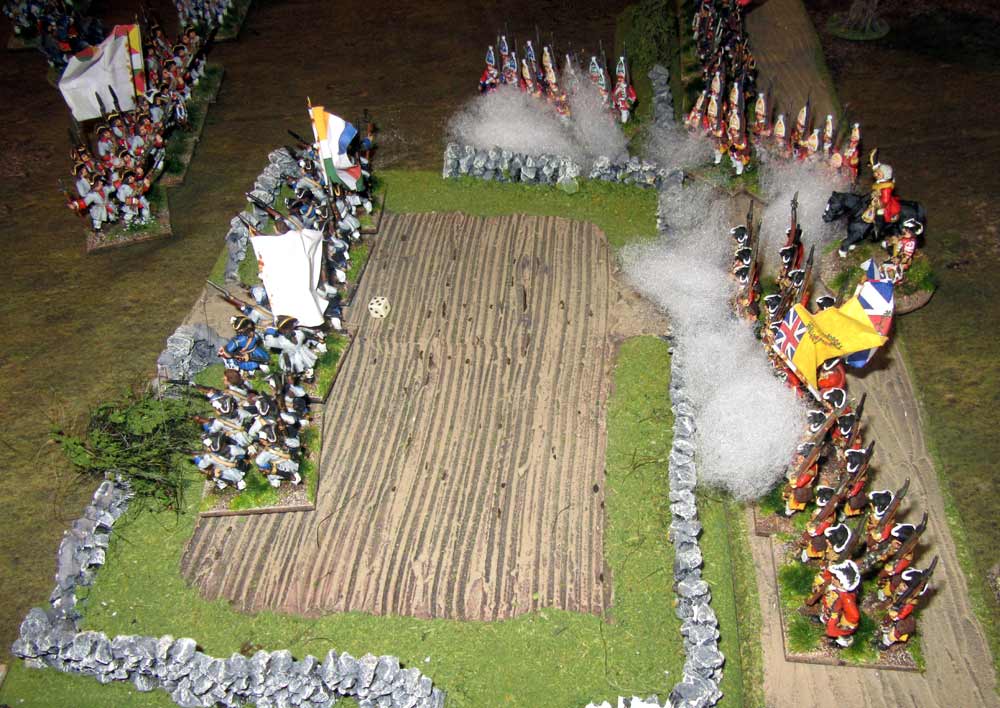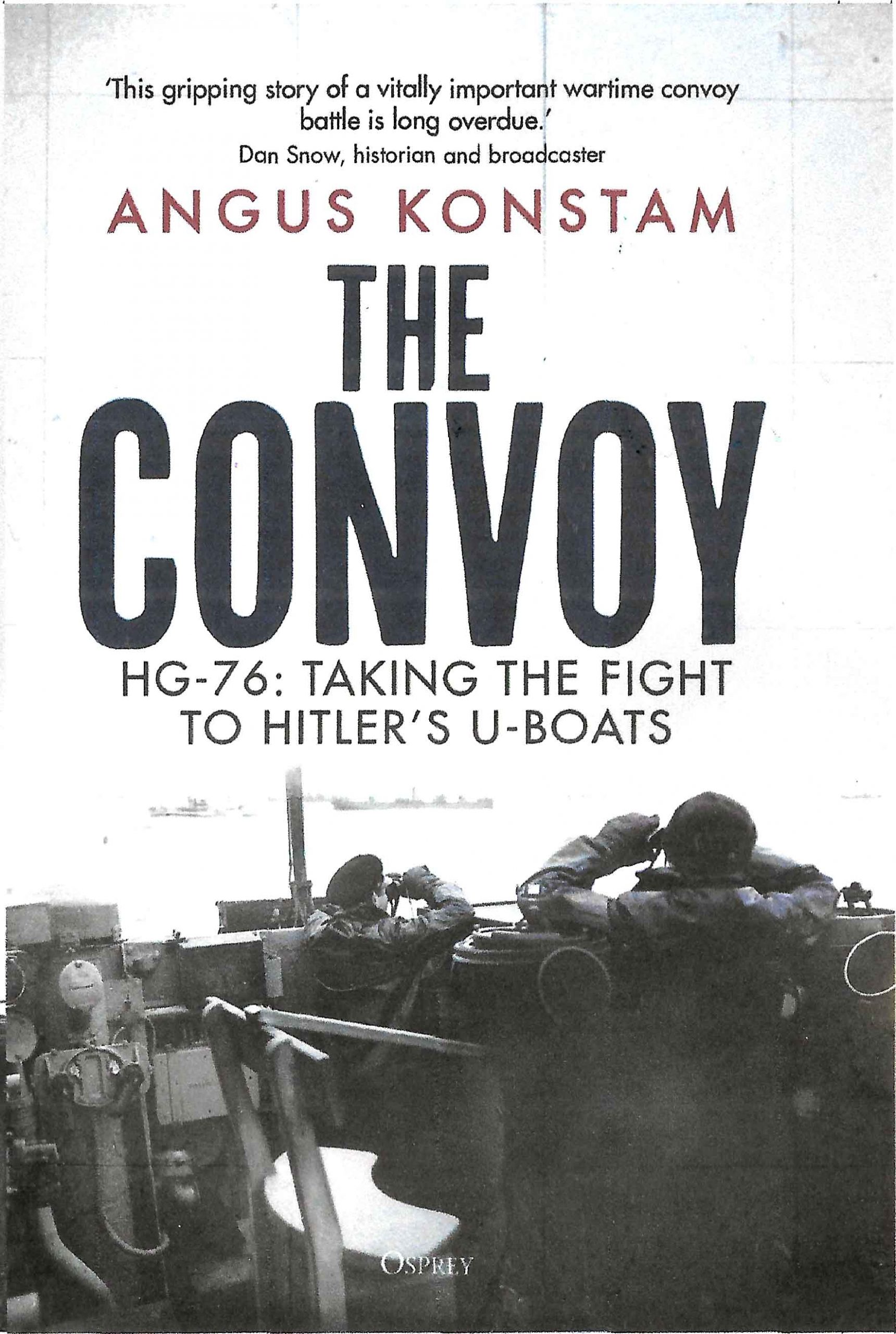
Battle of Lichtenau, 1760
15th September 2024, 9 Comments
The Seven Years War, Honours of War, 28mm
It’s been a while since I’ve played a Seven Years War game. I think the last was just before ‘Sean 2’ slunk away south. So, I was delighted when visiting wargamer Sam said he liked the period, and we were able to stage a small game. In this one, I had a French force of six battalions and two cavalry regiments, while Sam had the same, but with an extra grenadier battalion, and a unit of light infantry. We played the game on a 6×4 foot table.  Apologies for the fuzzy picture. My cavalry were on the left, with a ‘Dashing’ commander, while the Allied cavalry matched them with their cavalry on the right. We both had a hussar regiment though, which we both posted on the other flank. My right flank commander (with the Royal Nassau hussars attached) was ‘Inept’, while Sam’s left-hand one – with the Prussian Black Hussars – was ‘Dashing’. Everyone else was competent.
Apologies for the fuzzy picture. My cavalry were on the left, with a ‘Dashing’ commander, while the Allied cavalry matched them with their cavalry on the right. We both had a hussar regiment though, which we both posted on the other flank. My right flank commander (with the Royal Nassau hussars attached) was ‘Inept’, while Sam’s left-hand one – with the Prussian Black Hussars – was ‘Dashing’. Everyone else was competent. The Allies won the initiative, and advanced all along the line. On the left, the ‘Dashing’ British commander General Kingsley had a double move, and his two British units, the 21st Foot and the combined Grenadier battalion began to threaten my lone French Cambresis battalion in a walled enclosure on my right. The Prussian hussars also advanced, and were faced off by the French Nassau hussars. In the firing, the French had the worst of it.
The Allies won the initiative, and advanced all along the line. On the left, the ‘Dashing’ British commander General Kingsley had a double move, and his two British units, the 21st Foot and the combined Grenadier battalion began to threaten my lone French Cambresis battalion in a walled enclosure on my right. The Prussian hussars also advanced, and were faced off by the French Nassau hussars. In the firing, the French had the worst of it.  On the French left, both sides were gearing up for a cavalry clash. the French La Reine dragoons were rated as inferior, and the Cuirassiers du Roy were superior, while the Allied Hessian and Hanovarian horse were regular. The tea mug – shockingly n the table – didn’t play much of a part in the battle. When the clash came though, the French dragoons were routed, as were the Hessian cavalry, while the Hanovarian Hodenberg regt. were forced to retreat.
On the French left, both sides were gearing up for a cavalry clash. the French La Reine dragoons were rated as inferior, and the Cuirassiers du Roy were superior, while the Allied Hessian and Hanovarian horse were regular. The tea mug – shockingly n the table – didn’t play much of a part in the battle. When the clash came though, the French dragoons were routed, as were the Hessian cavalry, while the Hanovarian Hodenberg regt. were forced to retreat.  So, it was a good outcome for the French on their left flank. In the main part of the battlefield though, the French didn’t move – they just waited for the Allies to advance within musket range. The Hanovarian jaegers though, headed for the farmyard just beyond the French line, and occupied it before the main clash began. In the distance, in the photo above, you can see the outnumbered Tournaisis battalion, suffering at the hands of the British.
So, it was a good outcome for the French on their left flank. In the main part of the battlefield though, the French didn’t move – they just waited for the Allies to advance within musket range. The Hanovarian jaegers though, headed for the farmyard just beyond the French line, and occupied it before the main clash began. In the distance, in the photo above, you can see the outnumbered Tournaisis battalion, suffering at the hands of the British.  That particular fight didn’t last long. The French infantry were regular, but the British grenadiers were ‘superior’, while the 21st Foot were regular, but rated ‘superior’ for shooting. Despite the French having a wall to hid behind they were shot to pieces, and eventually routed off the field. Meanwhile, the two hussar regiments fought it out too, and this time the Royal Nassauers were routed, while the Prussians merely retreated to lick their wounds.
That particular fight didn’t last long. The French infantry were regular, but the British grenadiers were ‘superior’, while the 21st Foot were regular, but rated ‘superior’ for shooting. Despite the French having a wall to hid behind they were shot to pieces, and eventually routed off the field. Meanwhile, the two hussar regiments fought it out too, and this time the Royal Nassauers were routed, while the Prussians merely retreated to lick their wounds.
 So, even before the main infantry clash, the British were victorious on one flank, and the French were in control of the other, especially after the French cuirassiers drove the last of the Allied cavalry off the table edge. The French deployment with a line in reserve wasn’t looking so clever now, as it gave the Allies the edge in numbers when the firefight got under way. Then there were the British, who could now turn the French right flank. Mon Dieu…
So, even before the main infantry clash, the British were victorious on one flank, and the French were in control of the other, especially after the French cuirassiers drove the last of the Allied cavalry off the table edge. The French deployment with a line in reserve wasn’t looking so clever now, as it gave the Allies the edge in numbers when the firefight got under way. Then there were the British, who could now turn the French right flank. Mon Dieu… In theory, when you march up to a waiting enemy, you’re going to suffer, as they’ll have the edge in musketry. However, it wasn’t too bad for the Allies, as I rolled poorly. In the end of the first exchange of musketry, the French were volley hit more than their opponents. Then, over on the French right, the British were starting to curve round and head towards the exposed French right flank. I needed a miracle – or really good dice – to turn the battle around…
In theory, when you march up to a waiting enemy, you’re going to suffer, as they’ll have the edge in musketry. However, it wasn’t too bad for the Allies, as I rolled poorly. In the end of the first exchange of musketry, the French were volley hit more than their opponents. Then, over on the French right, the British were starting to curve round and head towards the exposed French right flank. I needed a miracle – or really good dice – to turn the battle around… However, it wasn’t my day. The Allied musketry was telling, and first one battalion of the Swiss La Planta regt. was forced to retreat, and then a battalion of the La Marine regt. was swept from the field. It was that extra couple of Allied units in the fioring lime that really made all the difference…
However, it wasn’t my day. The Allied musketry was telling, and first one battalion of the Swiss La Planta regt. was forced to retreat, and then a battalion of the La Marine regt. was swept from the field. It was that extra couple of Allied units in the fioring lime that really made all the difference… I was now teetering on the brink of defeat. One more broken unit and I’d officially lose the game. I pulled back to the hill behind me, where I tried to rally units, while putting up some kind of a defence. It wasn’t to be though – I was outmatched and outnumbered, and now the British were deploying on my right flank. The only ace up my sleeve was my remaining cavalry regiment. It was now behind the Allies. Could a glorious charge turn the tide?
I was now teetering on the brink of defeat. One more broken unit and I’d officially lose the game. I pulled back to the hill behind me, where I tried to rally units, while putting up some kind of a defence. It wasn’t to be though – I was outmatched and outnumbered, and now the British were deploying on my right flank. The only ace up my sleeve was my remaining cavalry regiment. It was now behind the Allies. Could a glorious charge turn the tide?  Of course that was when I lost my last unit – the La Cambresis battalion holding my right flank. It was shot to pieces by the British grenadiers. So, the French had lost, the last ride of the Cuirassiers du Roy wasn’t to be. It was a great little game though, and I was comprehensively outfought by Sam, who never really put a foot wrong all game. Above all though, it was great to get back into my favourite period again, and get my toys out on the table!
Of course that was when I lost my last unit – the La Cambresis battalion holding my right flank. It was shot to pieces by the British grenadiers. So, the French had lost, the last ride of the Cuirassiers du Roy wasn’t to be. It was a great little game though, and I was comprehensively outfought by Sam, who never really put a foot wrong all game. Above all though, it was great to get back into my favourite period again, and get my toys out on the table! 


Angus, as always top reporting on a fabulously setup table. Absolutely inspiring. I’ve restarted my blog, do come have a peek and maybe say hello. Early days yet, but slowly building up.
https://nyudrevchronicles.blogspot.com/
Happy gaming!
Peter
I’m now following your blog, Peter, which looks fascinating.
Good luck with it!
That is indeed very kind of you. You may have noticed a link to this website in my favourite places section of the Chronicles.
And now another twenty horses to clean and then start reassembling the troops.
Best wishes
The SYW is my favourite period, so great to see this report. Thanks
Mine too Peter, but there’s been a bit of a hiatus this year, for various reasons. We’ll remedy that over the coming months!
Another nice AAR with great looking troops too. Only sad part was the French lost. Well, they did seem to be outnumbered and often outclassed in ratings too. Such is war.
Thanks Joe. We ‘rolled up’ the sides, so the two sides were similar but slightly unequal. My poor French were very much the underdogs. C’est, is vie!
Here is the HoW-fan! Great to see French redcoats and Hanoverian redcoats again in action.
French are almost always the underdogs except if they have huge numbers…
The French certainly have ‘challenges’, especially early in the war.
Thank goodness for the German and Swiss regiments – the spine of any French defence.